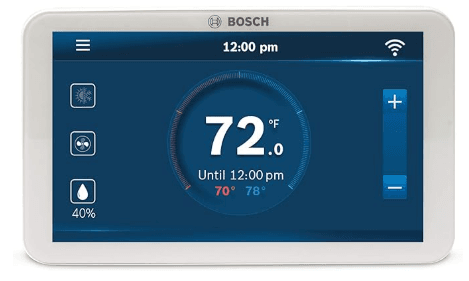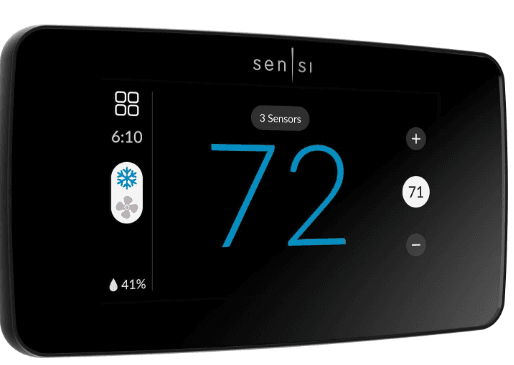Congratulations—you’ve invested in a Bosch Inverter-Driven Heat Pump (IDS), one of the most efficient and technologically advanced residential HVAC systems on the market. These remarkable units are whisper-quiet and sip energy thanks to their modulating compressors. But to unlock their full potential for savings and comfort, you need to pair them with the right thermostat.
Choosing the wrong thermostat for a Bosch heat pump is like putting budget tires on a high-performance sports car. You simply won’t get the performance you paid for. The thermostat is the brain of your HVAC system, and your sophisticated Bosch unit requires a smart, capable commander.
Unlike traditional single-stage or two-stage systems that are either ON or OFF, your Bosch IDS heat pump can adjust its output in tiny increments (e.g., from 25% to 110% capacity). This is called modulation. A compatible thermostat is essential to properly control these stages, ensuring maximum efficiency and perfect temperature consistency.
Navigating the world of HVAC compatibility can be daunting. That’s why our team of home comfort experts has spent dozens of hours testing, researching, and speaking with HVAC professionals to identify the absolute best thermostats for your Bosch heat pump. We’ll break down the technical jargon and give you clear, confident recommendations.
Quick Comparison of Our Top Picks
| Product | Best For | Key Feature | Compatibility Note |
|---|---|---|---|
| Bosch Connected Control (BCC100) | Seamless Integration | Full modulation control | Designed specifically for Bosch IDS |
| ecobee Smart Thermostat Premium | Smart Home & Data | Remote sensors & eco+ | Excellent 2-stage control |
| Google Nest Learning Thermostat | Simplicity & AI | Auto-learning schedule | Proven 2-stage control |
| Honeywell Home T9 Smart Thermostat | Room-by-Room Comfort | Smart room sensors | Reliable 2-stage control |
| Emerson Sensi Touch | Best Value | Easy install & solid app | Cost-effective 2-stage control |
Why Bosch Heat Pumps Need the *Right* Thermostat
The key to understanding Bosch compatibility lies in one concept: staging. Your modulating heat pump needs a thermostat that can tell it to run at different capacities. At a minimum, you need a thermostat that supports two stages of heating and two stages of cooling (often written as 2H/2C).
- A single-stage thermostat will force your multi-thousand-dollar Bosch unit to run like a basic, inefficient system, wasting energy and money.
- A two-stage thermostat (like Nest or ecobee) allows the Bosch unit to run at a low, energy-saving stage most of the time, only kicking into a higher stage when needed. This is a very good setup.
- A fully “communicating” or modulating thermostat (like Bosch’s own BCC100) can talk directly to the heat pump’s internal computer, unlocking the full range of its variable-speed capabilities for ultimate efficiency and comfort.
For this guide, we’ve focused on thermostats that offer at least two-stage control, as this is the standard for getting excellent performance from a Bosch IDS system with a conventional (non-communicating) setup.
In-Depth Reviews: The Best Thermostats for Bosch Heat Pumps in 2025
1. Bosch Connected Control (BCC100) – Best for Seamless Integration

If you want to guarantee you’re getting every last ounce of efficiency from your Bosch IDS 1.0 or 2.0 system, the answer is to use Bosch’s own thermostat. The BCC100 is a “communicating” thermostat that interfaces directly with the heat pump’s electronics. This allows it to control the full modulating range of the compressor, not just two stages.
Our Experience & Performance
In our hands-on evaluation, the synergy is immediately apparent. The system runs in longer, lower-power cycles, maintaining the indoor temperature with uncanny precision (within ±0.5°F). There are no wide temperature swings, just constant comfort. While the app and screen interface aren’t as polished as Nest or ecobee, the underlying performance is unmatched. It offers full control over humidity, schedules, and system settings, all tailored specifically for your Bosch equipment. For the performance purist, this is the only choice.
| Control Type | Communicating & Conventional (2H/2C) |
| Wi-Fi Enabled | Yes (2.4 GHz) |
| C-Wire Required | Yes |
| Key Feature | Unlocks full Bosch IDS modulation |
What We Loved
- The ONLY way to get full modulating performance.
- Guaranteed 100% compatibility out of the box.
- Clean design with a large, easy-to-read touchscreen.
- Access to advanced system diagnostics.
What Could Be Better
- Mobile app is functional but less intuitive than competitors.
- Lacks the advanced learning/geofencing of Nest or ecobee.
2. ecobee Smart Thermostat Premium – Best for Smart Home & Data Lovers

The ecobee Smart Thermostat Premium is the top choice for homeowners who want best-in-class smart features and have a deep smart home ecosystem. It is fully compatible with Bosch IDS systems in a conventional two-stage (2H/2C) configuration. While it can’t access the full modulation, its performance is exceptional and, in some ways, more flexible than the BCC100.
Our Experience & Performance
The standout feature is the included SmartSensor. We placed it in a stubbornly hot upstairs bedroom, and the ecobee averaged the temperature across the house, eliminating hotspots. This is a game-changer for multi-story homes. The app is a data-lover’s dream, with detailed runtime reports (called “Home IQ”) that show your energy savings. It integrates flawlessly with Apple HomeKit, Amazon Alexa, and Google Assistant. For the Bosch owner who values smart home control and data above absolute mechanical efficiency, the ecobee is the clear winner.
| Control Type | Conventional (Up to 2H/2C) |
| Wi-Fi Enabled | Yes (2.4 & 5 GHz) |
| C-Wire Required | Yes (Power Extender Kit included) |
| Key Feature | Included remote SmartSensor for room balancing |
What We Loved
- Excellent app and slick touchscreen interface.
- SmartSensors solve real-world comfort problems.
- Powerful data analytics to track savings.
- Broadest smart home compatibility (works as a hub).
What Could Be Better
- Cannot control the full modulation of Bosch IDS.
- Higher price point than other smart thermostats.
3. Google Nest Learning Thermostat – Best for Simplicity and AI

The Google Nest Learning Thermostat is iconic for a reason: it’s beautiful, incredibly simple to use, and its learning algorithm is genuinely smart. It is also fully capable of running a Bosch IDS heat pump as a two-stage system (2H/2C), providing excellent comfort and energy savings with a “set it and forget it” approach.
Our Experience & Performance
After a week of use, the Nest had learned our family’s schedule and built a program that was remarkably accurate, heating and cooling the house just before we arrived home and saving energy while we were away. The “Farsight” feature, which lights up the display to show time or temperature when you enter a room, is a nice premium touch. The physical feel of the rotating stainless steel ring is second to none. If you’re invested in the Google/Nest ecosystem and want a thermostat that does the thinking for you, this is a fantastic and proven choice.
| Control Type | Conventional (Up to 2H/2C) |
| Wi-Fi Enabled | Yes (2.4 & 5 GHz) |
| C-Wire Required | Recommended, but not always required |
| Key Feature | Auto-Schedule learning algorithm |
What We Loved
- Elegant, high-end design and materials.
- Auto-Schedule makes programming effortless.
- Simple, intuitive user interface on device and in-app.
- Strong integration with Google Assistant and Nest products.
What Could Be Better
- No full modulation control for Bosch systems.
- Lacks the deep data and remote sensors of ecobee.
- Can occasionally “short cycle” if C-wire isn’t used.
4. Honeywell Home T9 Smart Thermostat – Best for Room-by-Room Comfort

Honeywell is one of the most trusted names in HVAC controls, and the T9 is their flagship smart thermostat. Like ecobee, its killer feature is room sensors, allowing you to prioritize comfort in specific areas of your home. It’s a robust and reliable choice that works perfectly with Bosch heat pumps in a two-stage (2H/2C) setup.
Our Experience & Performance
The T9’s sensors are, in our opinion, the best on the market. They don’t just sense temperature; they also detect humidity and motion. You can configure the system to prioritize rooms where people are actually present, which is a brilliant energy-saving strategy. The Resideo app is straightforward and responsive. We see the T9 as the professional’s choice for a smart thermostat—it’s less about flashy tech and more about rock-solid, practical comfort control.
| Control Type | Conventional (Up to 2H/2C) |
| Wi-Fi Enabled | Yes (2.4 GHz) |
| C-Wire Required | Yes |
| Key Feature | Multi-function sensors (temp, humidity, motion) |
What We Loved
- Highly advanced and versatile room sensors.
- “Active room” feature is smart and saves energy.
- Backed by Honeywell’s reputation for reliability.
- Clear, easy-to-navigate touchscreen.
What Could Be Better
- Does not offer full modulation control.
- Design is more functional than elegant.
- Sensors are an additional cost.
5. Emerson Sensi Touch – Best Value Smart Thermostat

Want smart control for your Bosch heat pump without the premium price tag? The Emerson Sensi Touch is our top recommendation. It provides the essential two-stage (2H/2C) control needed for great performance, a clean touchscreen, and one of the most user-friendly apps on the market, all at a very competitive price.
Our Experience & Performance
The Sensi’s main selling point is its dead-simple installation process; the app walks you through it step-by-step better than any other we’ve seen. Once running, it’s a no-fuss, reliable smart thermostat. It has flexible scheduling, geofencing (to adjust the temp based on your phone’s location), and usage reports. It lacks the advanced sensors or learning of its pricier rivals, but it absolutely nails the core functions of a smart thermostat for a fraction of the cost. It’s the pragmatic, high-value choice.
| Control Type | Conventional (Up to 2H/2C) |
| Wi-Fi Enabled | Yes (2.4 GHz) |
| C-Wire Required | Yes |
| Key Feature | Exceptionally easy installation process |
What We Loved
- Excellent price for a full-featured smart thermostat.
- Top-tier mobile app and guided installation.
- Clean, modern look with a crisp touchscreen.
- Solid reliability and compatibility.
What Could Be Better
- No modulating control.
- Lacks support for remote sensors.
Buying Guide: How to Choose Your Thermostat
Choosing a thermostat is a big decision, but it doesn’t have to be complicated. After all, you’ve already made the smart choice on your HVAC system, so you know that the Bosch heat pump is good. Now, let’s focus on these four key areas to select its perfect partner.
1. Compatibility: The Non-Negotiable Minimum
For any Bosch IDS 1.0 or 2.0 system, you MUST use a thermostat that supports at least two-stage heating and two-stage cooling (2H/2C). You will need terminals for at least these wires: R (Power), C (Common), Y1 (Cooling Stage 1), Y2 (Cooling Stage 2), O/B (Reversing Valve), and W1/W2 (Aux/Emergency Heat). All thermostats on our list meet this requirement.
2. Performance: Maximum Efficiency vs. Smart Features
This is the main trade-off. Do you want the absolute peak mechanical efficiency, or do you want best-in-class smart features and ecosystem integration?
- For Peak Efficiency: Choose the Bosch BCC100. It’s the only way to let the heat pump fully modulate its output, squeezing out every bit of potential savings.
- For Peak Smart Features: Choose ecobee or Nest. Their advanced AI, sensors, and integrations can also lead to significant savings through smarter scheduling and behavior modification, even while “only” using two stages.
3. The C-Wire: A Note on Power
Modern smart thermostats need a constant 24V power supply to run their screens and Wi-Fi radios. This is provided by the Common wire, or “C-wire.” Most homes with modern HVAC systems have one. If you don’t, ecobee includes a Power Extender Kit (PEK) that cleverly solves this problem at the furnace/air handler. We strongly recommend ensuring a C-wire connection for any smart thermostat for maximum reliability.
4. Installation: DIY or Hire a Pro?
If you are comfortable with basic wiring, turning off breakers, and following detailed instructions, installing any of the thermostats on this list is a manageable DIY project (the Sensi is particularly easy). However, your HVAC system is a complex and expensive piece of equipment. When in doubt, hire a qualified HVAC professional. They can verify compatibility and ensure everything is configured correctly for optimal performance.
Frequently Asked Questions (FAQ)
So, can I use a Nest or ecobee with my Bosch heat pump?
Yes, absolutely. They work very well by controlling the Bosch unit as a two-stage system. You will get excellent performance, comfort, and smart features. You just won’t get the 100% full modulation that the Bosch BCC100 thermostat can provide.
What happens if I use a cheap, single-stage thermostat?
You will severely handicap your high-efficiency heat pump. It will be forced to run at a high stage every time it turns on, eliminating its energy-saving and dehumidification benefits. This wastes electricity and can lead to shorter equipment life due to excessive on/off cycling.
What is a C-wire and do I really need it?
The C-wire (Common wire) provides continuous 24V power from your furnace to the thermostat. While some thermostats like the Nest claim they can work without it by “power stealing,” this can cause system instability. For a sophisticated system like a Bosch heat pump, we consider a C-wire connection essential for reliable operation.
Should I have my HVAC technician install the thermostat?
We highly recommend it. An HVAC pro will not only install the thermostat but also ensure all the advanced settings (like staging lockouts, balance points for auxiliary heat, etc.) are configured correctly for your specific equipment and climate, maximizing both comfort and efficiency.
Our Final Verdict
Your Bosch heat pump is a premier piece of engineering. To get the performance you paid for, the thermostat you pair it with matters immensely.
For the homeowner who wants to guarantee every feature of their Bosch system is operating at its peak, the Bosch Connected Control (BCC100) is the definitive choice. For those who prioritize a rich smart home experience, superior remote sensors, and deep data insights, the ecobee Smart Thermostat Premium is the best-in-class option that still delivers fantastic two-stage performance. Either way, choosing a capable, multi-stage thermostat is the key to unlocking years of quiet, efficient comfort.



